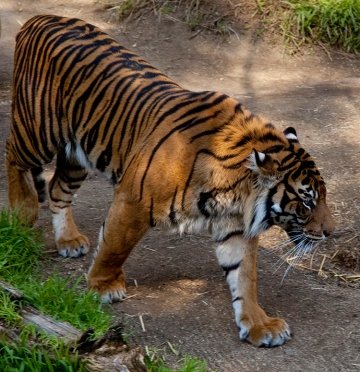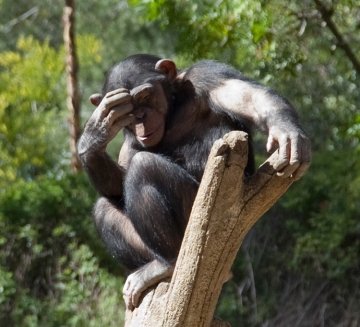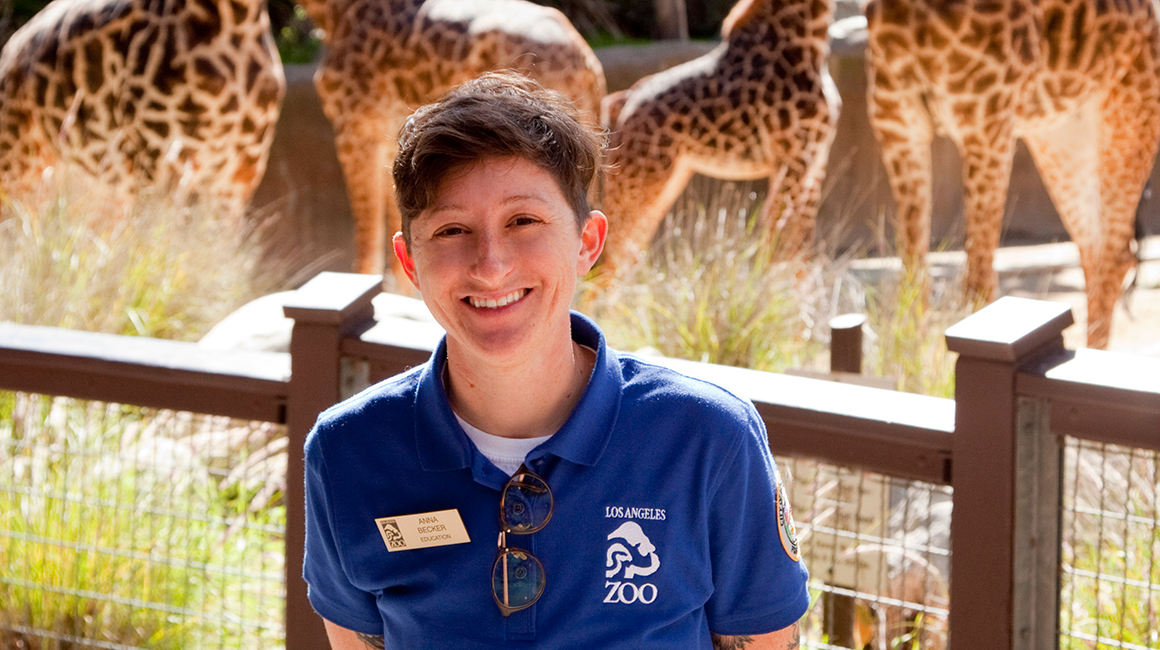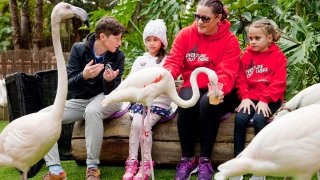On a breezy Thursday morning, several educators wait in an auditorium at the Los Angeles Zoo, ready to welcome students from nearby Colfax Charter Elementary.
Clad in the true-blue polo of an education team member, Anna Becker MAT ’18 prepares with her team.
The telltale musical notes of Britney Spears’s “Toxic” ring out as Becker’s phone goes off. Colfax isn’t coming; outside, some ominous clouds move in on a bright slate of sky, and in this city, rain is a crisis.
But other visitors undeterred by the weather continue filing into the park, and so the educators disperse to tend to them.
The Los Angeles Zoo and Botanical Gardens opened in November 1966. More than 50 years later, the institution now has 1,400 animals, including 58 endangered species. Seven hundred docents work the 133-acre grounds that hosted 1.8 million visitors last fiscal year.
Becker and her colleagues are responsible for how the public learns at the zoo. The guiding ethos is to design experiences with intention—not “here’s a cool sea lion,” but rather “here’s a lesson in empathy and inquiry, and it happens to be about a sea lion.” By the end of a visit, ideally, people leave the zoo thoughtful about their own places in nature, and their responsibilities toward the planet.
“We work here because we want to save the world,” Becker says. “We want to save animals; we want to save species; we want to do something big.”
A home in the wild
Walking the zoo grounds, Becker’s in her element—chatting up visitors, picking up litter, steering kids toward the best spot to watch otters rip the heads off tilapia.

But growing up in Chicago, she was a self-described “shy and awkward teenager” who spent weekends with her dad exploring—and later volunteering for—the city’s Brookfield Zoo. After starting work on her degree in biological sciences at the University of Wisconsin–Madison, Becker landed an internship out west at Newport Beach’s Back Bay Science Center. Her three months there turned into six, and after a quick stop back east to complete her degree, she returned to California for good, joining the L.A. Zoo.
“As I volunteered, I found my people,” she says, crediting the zoo’s educators with making her understand the possibilities associated with teaching. “I realized it was something I was really passionate about, and that I wanted to make a career.”
The zoo’s education team has 50 part-time teachers and about a dozen more full-time staffers. It’s an eclectic group, united by one very important factor.
“We all get here in our own way,” Becker says. “I think it’s a tribute to all of us having a passion for conservation and animals.”
Leveling up
Becker enrolled at USC Rossier in 2016 to learn the formal science of teaching. Being able to think about how people process information differently, and how to create curricula in a more structured way, offered many opportunities.

As one of the zoo’s four full-time curators of education, Becker is responsible for providing support for the education team and developing new learning programs. Current programs have been designed around Next Generation Science Standards or Common Core State Standards, rather than trying to slip new standards into pre-existing programs.
Much of Becker’s work centers on getting educators to step out of their comfort zones and let visitors drive where the presentations go.
“Too often,” she says, “we can spit out facts and overload them with information.”
The educators practice visual and thinking strategies to better understand how to engage their audiences in their talks, and get them excited about the information.
Jess Kohring, the manager of school and on-grounds programs, says the education team is always looking for new ideas but the pedagogy remains the same.
“It’s about building up a skill set of observing nature literacy, slowing down and asking questions,” Kohring says.
A city zoo
In 2016, the Los Angeles County Department of Parks and Recreation issued a comprehensive report citing the poor level of park access for Los Angeles residents, finding that just over half of residents live at least a half-mile away from a park.

And so the L.A. Zoo sees itself as a reliable resource. During the LAUSD strike in January 2019, for instance, the park offered free programming for students and parents.
The past several years have brought a load of new programs designed by the education team. There are overnights. There are chances to learn animal husbandry with seals. There are opportunities to break down the normal barriers of a zoo and get up close with hippos. A new favorite, the Flamingo Mingle, lets visitors offer up krill water to juvenile pre-pink birds with zero respect for personal space.
Forty percent of the 140,000 annual student visitors come from LAUSD schools. Under the guidance of education director Dan Keeffe, the zoo implemented a new program in 2018 that offers scholarships for Title I schools and includes free transportation, admission and programming.
The scholarships are a way to reduce inequity. Low-income students, Black students and Hispanic/Latino students are less likely than others to have access to parks and the benefits they provide, as suggested in a 2018 study from the University of British Columbia. The zoo estimates its scholarship program will serve 85 schools and more than 5,300 students this school year.
When students visit, they start slow, getting friendly with something fuzzy (rabbits are popular) and always—always—one thing that creeps on more than four legs. Before Colfax Elementary had to cancel, they were getting cockroaches.
Empathy is key to the zoo’s mission, Becker says. And if you can find empathy with a cockroach, empathizing with other wildlife—and taking steps to protect them and their world—only gets easier.
“I felt like if I could educate the general public on a day-to-day basis as part of my job, I could start to change the lives of individuals, people in our community, in our city and nationwide,” she says. “We do that every day, in little ways, in good ways.”





